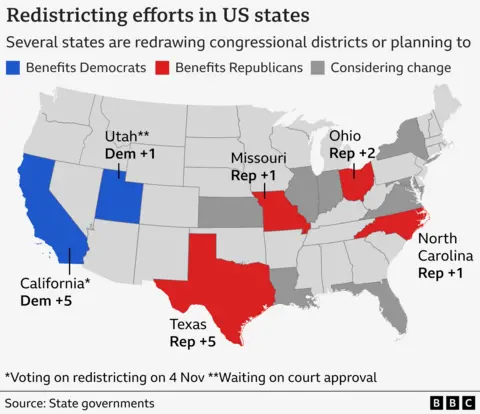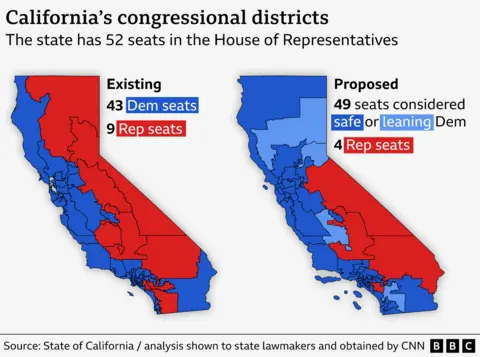Christal HayesLos Angeles

 Getty Images
Getty Images
Voters in California have approved a measure to redraw political lines to favour Democrats - launching a counterattack against similar efforts by conservative-led states in a nationwide battle for control of the US House of Representatives
CBS projects that the redistricting measure, called Prop 50, passed.
It is aimed at reconfiguring the state's voting districts to give Democrats better chances at taking five House seats from Republicans during next year's midterm elections.
Whether the measure will tip the balance of power in Washington remains unclear as more Republican-led states are also redrawing their voting lines under pressure from President Donald Trump.
Currently, Republicans hold a small, five-seat majority in the 435-member House of Representatives, the lower chamber of Congress.
If Democrats win a majority in the chamber in the 2026 election, they will be able to stunt Donald Trump's legislative agenda for at least the next two years and also lead congressional oversight of his administration - action that could range from investigations, complete with subpoenas, to impeachment.
A look nationally shows the effort in Democrat-heavy California won't be enough on its own to cancel out gains by Republicans who have also redone voting maps. Four Republican-led states have already redrawn their lines so far this year, giving the party a likely advantage in nine new voting districts.
Still, experts told the BBC that those changes to districts might not be enough for Republicans keep control of the House next November.
They are called midterm elections, where voters cast ballots for congressional candidates as well as state ones, because they take place in the middle of a president's four-year term. Historically, a president often loses power of at least one chamber in Congress in the midterms.
- LIVE REPORTING: Millions vote in New York and across US in first major electoral test of second Trump term
The Brookings Institution has found that the party of the president lost House seats in 20 of the last 22 midterm elections - going back to 1938.
"There are a lot of unknowns still and a lot can happen before the midterms politically, but looking at it historically - this is an uphill battle for Republicans," said Galen Sheely, research director for the State Voting Laws Roundup project, a collaboration between the Brennan Center for Justice and the Goldman School of Public Policy at the University of California, Berkeley.
Redistricting typically is done once every 10 years, to reflect population changes recorded by the US Census.
Redrawing voting lines in the middle of the decade to try to engineer election gains is "a new strategy that is pushing boundaries that haven't been pushed before", Dr Sheely added.
The tit-for-tat redistricting battle started with Trump pressuring conservative-led states to redraw their congressional districts to help Republicans retain control of the House. Now, more than a dozen US states are openly mulling plans to redraw voting lines - known as political gerrymandering.
"Regardless of whether it's Democrats or Republicans, this is just not good for our republic in the long term," said Erik Nisbet, a professor at Northwestern University. "The question now is where does this stop? It's political sabotage to our democracy."


From his viewpoint, the battle runs the risk of both eroding trust in the government, with people seeing their votes and representation in Washington diminished, along with erasing battleground districts where members of both parties have equal shots at winning the seat.
Representatives from those districts often are crucial to negotiating deals and finding middle ground - things that have become harder in Congress amid a bitter political divide, he said.
"It's hard to not mention the ongoing government shutdown in this," he added. "This will worsen polarisation and gridlock in Congress. And the ripple effect of that will mean emboldening this president and future presidents to act unilaterally without Congress."
Trump, who began his redistricting push with Texas, has argued that he and Republicans are entitled to more congressional seats due to him winning those states in the 2024 presidential race.
Texas responded to Trump's call by redoing its maps to give Republicans an advantage in five new seats. And in turn, California Democrats introduced Prop, short for "Proposition", 50.


California's governor, Democrat Gavin Newsom, a Trump foe with reported presidential ambitions, championed Prop 50. He is now pushing Democrats to follow his lead and fight fire with fire - something he argues the party hasn't been willing to do in the past.
"These folks don't play by the rules," he has said of Republicans. "If they can't win playing the game with the existing set of rules, they'll change the rules. That's what Donald Trump has done."
High-profile Democrats, including former President Barack Obama, Rep Alexandria Ocasio Cortez and Kamala Harris helped fundraise and generate support for the measure across the country.
Campaigns in support of the measure and against it received $200m total, but Democrats far outraised Republicans, with Newsom telling donors last week that they could stop sending in money.
If other states do not join in, though, the proposition and its momentum may not lead to a significant change in the House.
While it could help score five seats for Democrats, more and more Republican-led states are also changing their maps.
North Carolina, Missouri and Ohio have all passed new maps that give Republicans a new edge. Utah has also passed a new map, which would give Democrats an advantage in one district, but it is under legal review.
Each state decides its voting districts differently and many Republican-led states have had an easier time changing their maps, due to their state laws, election deadlines, current districts or political leadership.
Texas, for instance, created its new districts through the state legislature.
California, though, needed voter support to change its political maps.
Under a state law intended to halt political gerrymandering, an independent commission usually sets California's voting districts once a decade. To deviate from that, the state had to call a special election, where Prop 50 was the only thing on the ballot, at a cost to taxpayers of more than $200m. The new Prop 50 maps will only be in use until 2030 when the commission will again redraw the districts.
As leaders in both liberal and conservative-leaning states look into redistricting, another factor is looming on the horizon, threatening to make an impact on the 2026 midterms: The Supreme Court is currently reviewing a case that - depending on the ruling - could drastically reshape how districts are drawn.
.png)
 1 month ago
11
1 month ago
11








 English (US) ·
English (US) ·